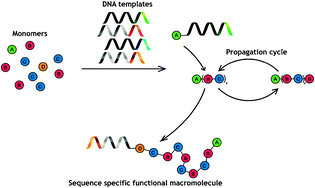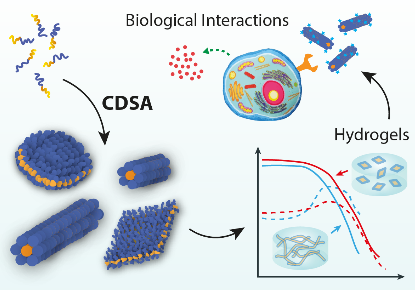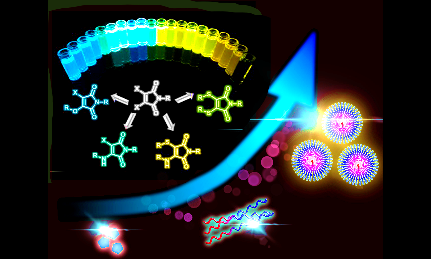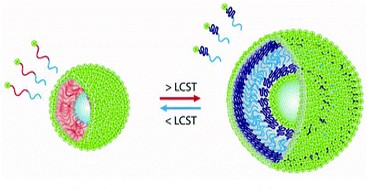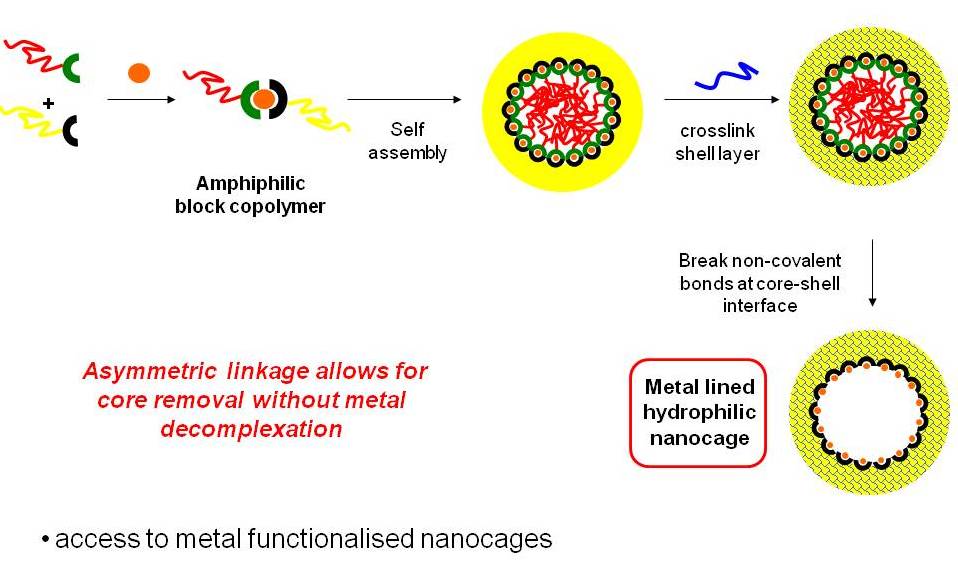Polymerisation-Induced Self Assembly (PISA)
Polymerisation-induced self-assembly (PISA) facilitates the preparation of polymer nanoparticles at high concentrations and/or in the presence of biomacromolecules. Our interests in this area are to understand structure-property relationships between block copolymer polymerisation kinetics/mechanism on assembly morphology and to apply these learnings to the formulation of enzyme- or drug-loaded nanoparticles for applications in medicine. In so doing, we have elucidated the role of hydrophobicity in block copolymer self-assembly, applied new polymerisation strategies to PISA, discovered novel pathways of morphological evolution, and revealed the role of nanoparticle permeability on enzymatically-catalysed reactions within polymeric nanoreactors, amongst other advances.
Ring-Opening Metathesis Polymerisation Induced Self-Assembly
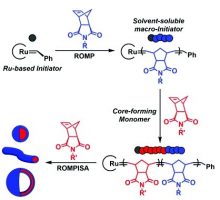
We have developed methodology to conduct aqueous ring-opening metathesis polymerisation (ROMPISA) using commercially available Ru-based catalysts. In addition to providing access to polymer amphiphiles with unique backbone and sidechain chemistries, our work on ROMPISA has revealed exceptional self-assembly behaviour with respect to morphology and morphological evolution. Recent studies have focused on the optimisation of ROMPISA under neutral conditions, the formation of tubular polymersomes (tubesomes) during polymerisation as the result of polymersome fusion, and on the permeability of polymersome membranes synthesised by ROMPISA. We are excited about the possibilities that ROMPISA offers as an alternative methodology to PISA using RAFT polymerisation.
It’s better with salt: Aqueous Ring-Opening Metathesis Polymerization at Neutral pH, J. C. Foster; M. C. Grocott; L. A. Arkinstall; S, Varlas; M. J. Redding; S. M. Grayson; R. K. O’Reilly, J. Am. Chem. Soc. 2020, DOI: 10.1021/jacs.0c05499
Ring-Opening Metathesis Polymerization-Induced Self-Assembly (ROMPISA), S. Varlas; J. C. Foster; R. K. O’Reilly, Chem. Commun. 2019, 55, 9066-9071, DOI: 10.1039/C9CC04445K
Polymerization-Induced Polymersome Fusion, S. Varlas; R. Keogh; Y. Xie; S. L. Horswell; J. C. Foster; R. K. O’Reilly, J. Am. Chem. Soc., 2019, 141, 51, 20234-20248; DOI: 10.1021/jacs.9b10152
Enzyme Loaded Nanoreactors
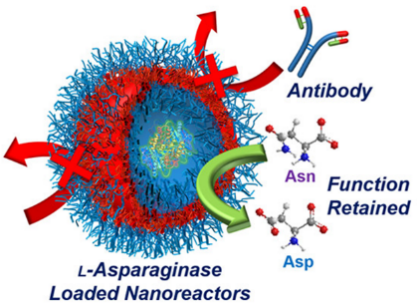
Polymer nanoreactors are generally comprised of polymer micelles or polymersomes that have been functionalised or loaded with catalytic moieties. Due to the mild reaction conditions required for PISA when using photo-mediated RAFT polymerisation, enyzmes and other sensitive biological cargos can be readily encapsulated within polymersomes. Entrapment of enzymes such as horseradish peroxidase (HRP) or glucose oxidase (GOx) within polymersomes protects them from degradation by external forces (i.e., proteases) and allows for triggered or selective catalysis via manipulation of polymersome membrane chemistry. Our group has pioneered the formulation of enzyme-loaded nanoreactors, demonstrated the advantages of enzyme encapsulation in cascade reactions, and studied the selectivity of polymersome membranes for enzyme substrates. The ultimate aim of this research is to develop cellular mimetic particles for future therapeutic applications.
Confinement of Therapeutic Enzymes in Selectively Permeable Polymer Vesicles by Polymerization-Induced Self-Assembly (PISA) Reduces Antibody Binding and Proteolytic Susceptibility; L. D. Blackman, S. Varlas, M. C. Arno, Z. H. Houston, N. L. Fletcher, K. J. Thurecht, M. Hasan, M. I. Gibson and R. K. O’Reilly, ACS Cent. Sci., 2018, 4, 718-723, DOI:10.1021/acscentsci.8b00168
Tuning the membrane permeability of polymersome nanoreactors developed by aqueous emulsion polymerization-induced self-assembly, S. Varlas, J. C. Foster, P. G. Georgiou, R. Keogh, J. T. Husband, D. S. Williams and R. K. O’Reilly, Nanoscale, 2019, 11, 12643-12654, DOI: 10.1039/C9NR02507C
Photoinitiated Polymerization-Induced Self-Assembly in the Presence of Surfactants Enables Membrane Protein Incorporation into Vesicles, S. Varlas, L. D. Blackman, H. E. Findlay, E. Reading, P. J. Booth, M. I. Gibson, R. K. O’Reilly, Macromolecules, 2018, 51, 6190-6201, DOI: 10.1021/acs.macromol.8b00994
PISA Structure-Property Relationships
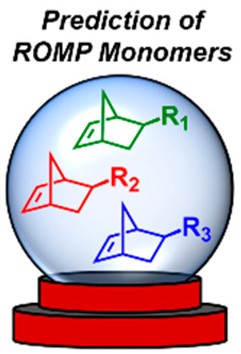
Our group, in collaboration with Prof. Robert Mathers at Penn State University, has developed computational and predictive methodologies for identifying monomers to be used to synthesise core-forming blocks during PISA. Our efforts in this area have focused on PISA using both RAFT polymerisation and ROMP. In addition to identifying novel monomer structures, this methodology has been used to explain PISA phenomena such as nanoparticle nucleation, morphological evolution, and nanoparticle phase behaviour.
We have also rigorously investigated the impacts of polymerisation conditions (i.e., initiation method, the presence/absence of surfactant, end group structure, etc.) on the morphologies obtained during PISA when using RAFT polymerisation. These learnings have enabled research in the areas of enzyme-loaded nanoreactors, drug delivery vehicles, and industrial formulations.
Getting into Shape: Reflections on a New Generation of Cylindrical Nanostructures Self-Assembly using Polymer Building Blocks, J.C. Foster, S. Varlas, Benoit C. Couturaud, Z. Coe, R.K. O’Reilly, J. Am. Chem. Soc, 2019, 141, 2742–2753, DOI: 10.1021/jacs.8b08648
Predicting Monomers for Use in Aqueous Ring-Opening Metathesis Polymerization-Induced Self-Assembly, S. Varlas, J. C. Foster, L. A. Arkinstall, J. R. Jones, R. Keogh, R. T. Mathers and R. K. O’Reilly, ACS Macro. Lett., 2019, 8, 466–472, DOI:10.1021/acsmacrolett.9b00117
Predicting Monomers for use in Polymerization Induced Self‐Assembly, J. C. Foster, S. Varlas, B. Couturaud, J. Jones, R. Keogh, R. T. Mathers, R. K. O’Reilly, Angew. Chem. Int. Ed., 2018, 57, 15733–15737, DOI: 10.1002/anie.201809614



